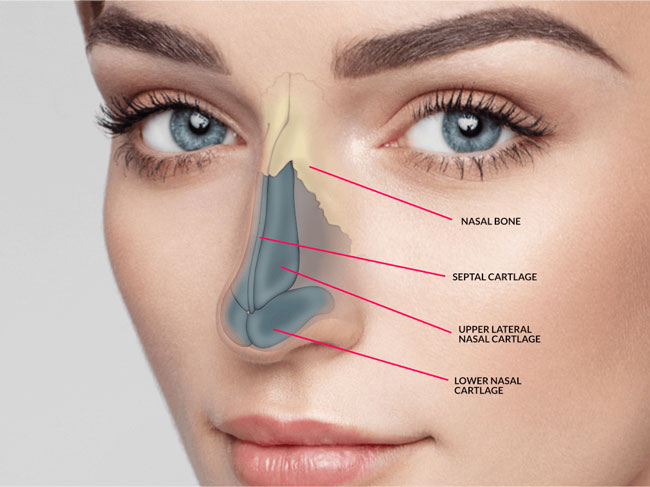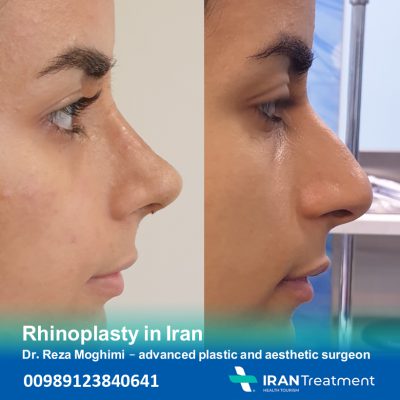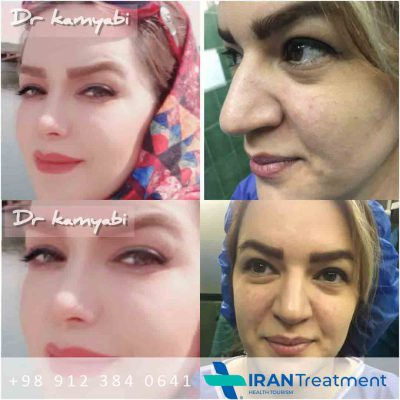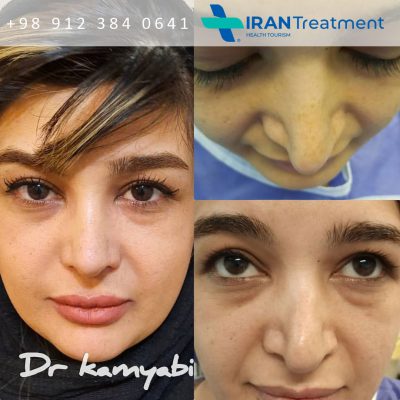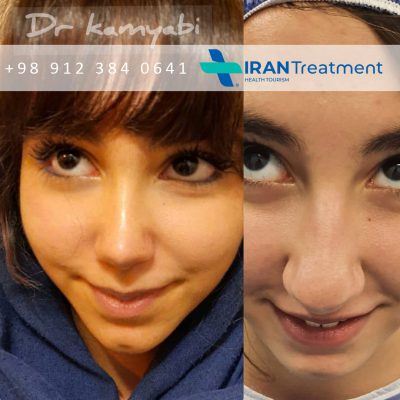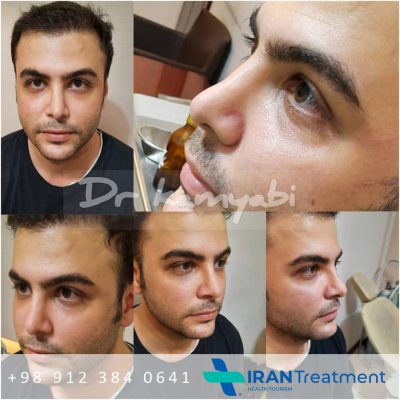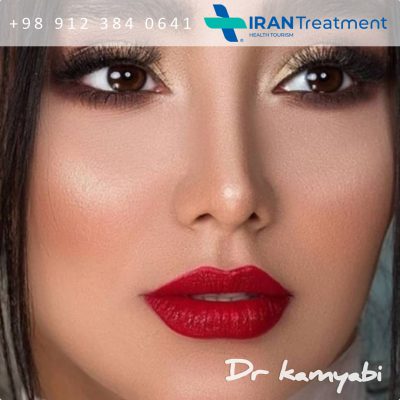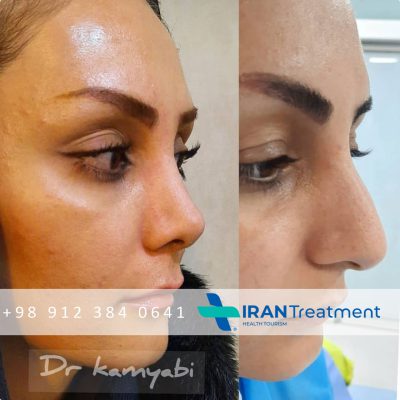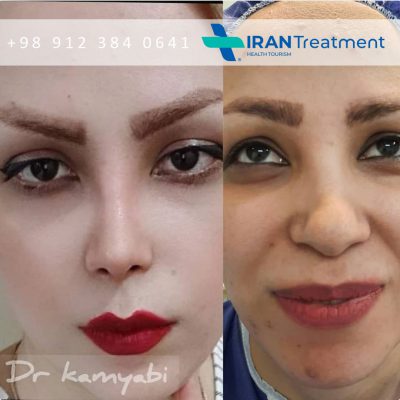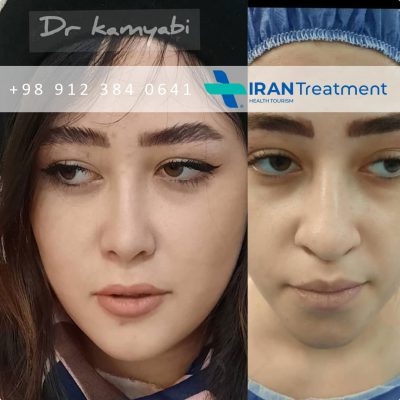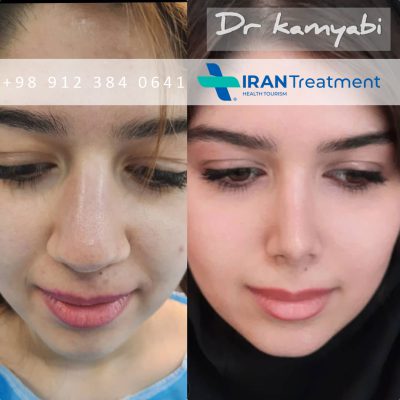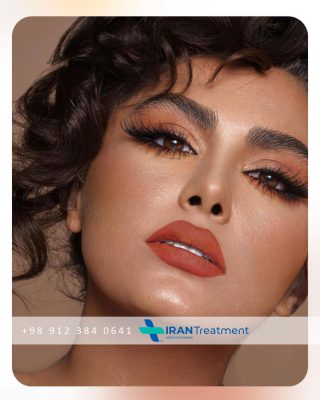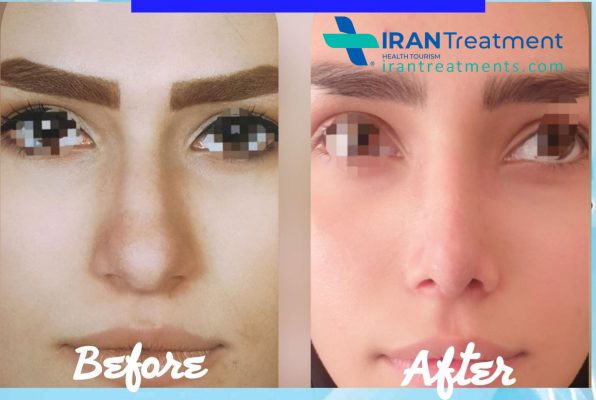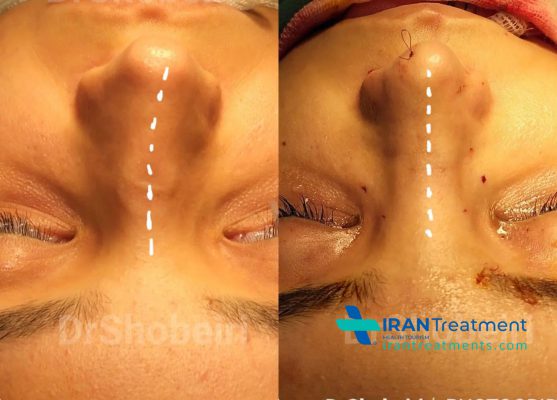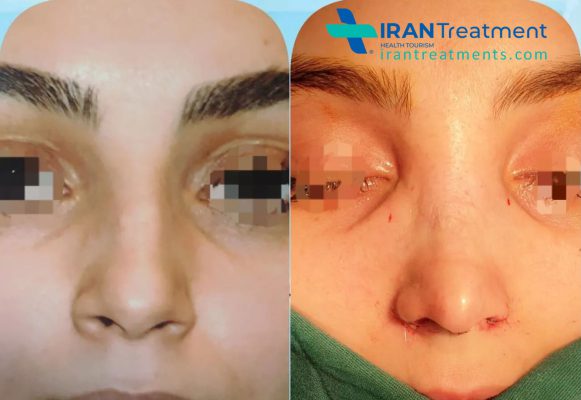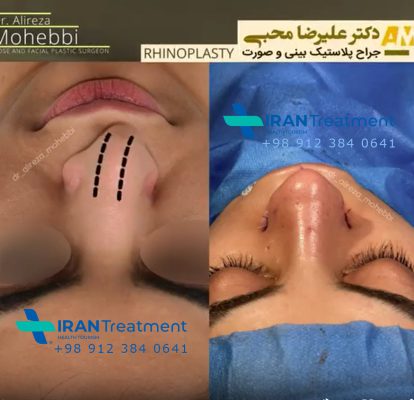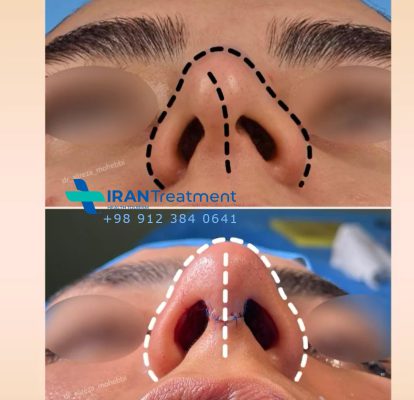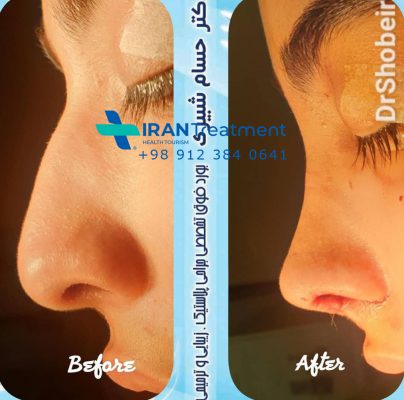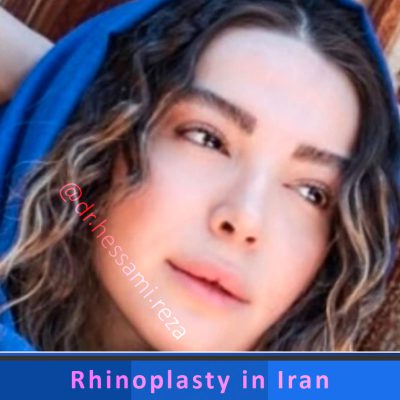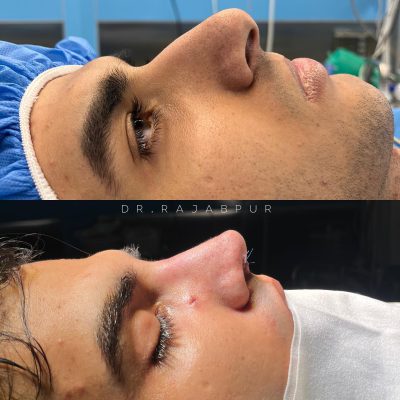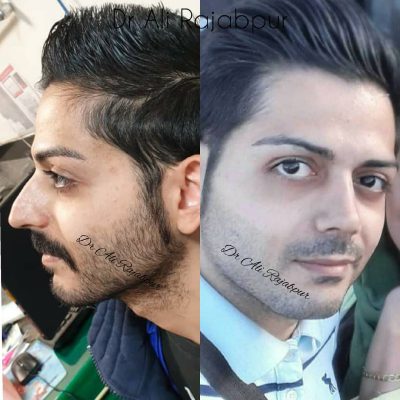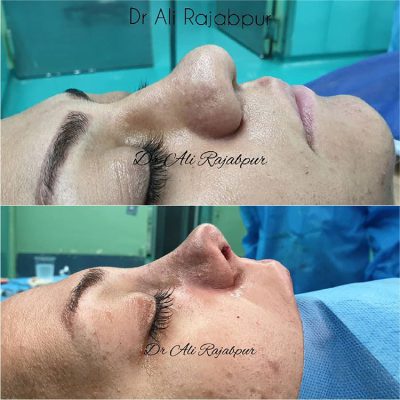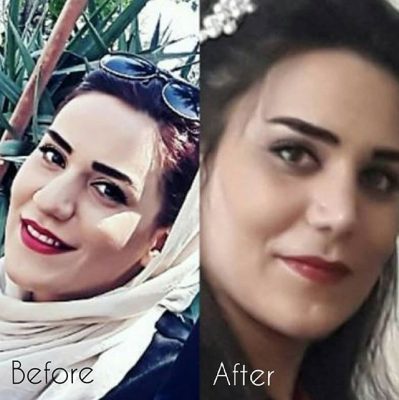Rhinoplasty in Iran
Rhinoplasty in Iran, also known as rhinoplasty, is a type of plastic surgery aimed at changing the shape of the nose or improving its respiratory functions. This type of surgery can include changing the size of the nose, adjusting the bridge or tip, smoothing furrows, or changing the angle between the nose and upper lip.
People who choose to have rhinoplasty in Iran may do so for cosmetic reasons or to improve the ability to breathe, or sometimes both. This choice is a personal decision and should be made based on good communication with the plastic surgeon and a clear understanding of expectations and potential results.
The procedure requires general or local anesthesia and is usually performed in a hospital or plastic surgery center. The surgeon adjusts the bone and cartilage in the nose to achieve the desired shape. After surgery, there can be some swelling and bruising, but these usually go away within a few weeks.
It is important to be aware that rhinoplasty surgery comes with a range of risks, including bleeding, infection, and adverse reactions to anesthesia. Also, the results may not always be what you expect, and a second surgery may be necessary to achieve the desired look.
As with any surgical procedure, you should carefully discuss your options with your doctor and plastic surgeon before deciding about rhinoplasty in Iran.
Types of rhinoplasty
Rhinoplasty in Iran, or rhinoplasty, comes in different types that suit the patient’s needs and goals. Here are some of the main types of rhinoplasty surgeries:
1. Cosmetic rhinoplasty: This surgery focuses on changing the shape of the nose to improve the overall shape of the face. It can include changes to the length, width, or other features of the nose.
2. Corrective rhinoplasty: This type of surgery aims to improve nasal functions, such as breathing. A person may have breathing problems due to a deformity of the nasal wall or due to other deformities of the nose.
3. Secondary (or secondary) rhinoplasty: This surgery is performed when a person has already undergone rhinoplasty but is not satisfied with the results, or when there are complications from the first surgery that require a second surgical intervention.
4. Non-surgical rhinoplasty: This procedure uses injections instead of surgery to change the shape of the nose. It may include filler injections to modify the overall shape of the nose. This option is less extensive but the results are often temporary.
Which type of surgery should be chosen based on individual needs and goals and after consultation with a professional plastic surgeon.
Rhinoplasty price in Tehran
- The cost of rhinoplasty in Tehran ranges between 1,000 and 3,000 euros
- There is usually no need to stay in the hospital and you will be discharged 4 hours after surgery.
- If you do not reside in Tehran, the duration of stay is 8 days
Cost of rhinoplasty for the first time |
1200 euros |
Including surgeon + hospital fees | |
| Other costs related to rhinoplasty in Tehran | |||
| Cost of blood test | Between 10 and 15 euros | The difference depends on the type of blood test | |
| Cost of ultrasound or CT scan of the nose | Between 40 and 60 euros | According to the surgeon’s order | |
| Cost of consultation with a cardiologist | Between 20 and 40 euros | For people over 40 years old or for heart patients | |
| Cost of medicines and other health items | Between 20 and 40 euros | ||
| The cost of plastic surgery in Tehran – Iran – optional | |||
| Nurse fee (per night) | 30 euros | If you are traveling alone | |
| The cost of changing dressings by the nurse | 15 euros | ||
attention:
- If you have an underlying illness or medication, let us know
- If you have already had rhinoplasty or have a broken nose, the cost of surgery will increase slightly
- Tell us if you have anemia or other blood disorders
- If you want to have an ethnic rhinoplasty and need to reconstruct the nose with cartilage, the cost of the nose will increase.
Types of nose in rhinoplasty
When performing rhinoplasty surgery in Iran, the original shape and size of your nose is an important factor in determining how the surgery will be performed and what the shape of the nose will be after surgery. Here are some common types of nose that can affect surgery:
1. Roman nose: This type of nose is characterized by a straight and long bridge that extends from the base to the tip.
2. Greek Nose: This type of nose is characterized by a straight, slender bridge, often straight from base to tip.
3. Aquiline nose: It is characterized by a curved or arched bridge, which is usually more noticeable for people who look at the face from the side.
4. Olive nose: This nose is long and thin with a rounded end.
5. Broad nose: This nose is characterized by a wide bridge and widened nasal wings.
6. Pointed nose: This nose is characterized by a sharp and pointed tip.
Bone nose surgery
Bone nose surgery, sometimes known as open rhinoplasty, is a procedure that requires modification of the bones in the nose. This surgery may be performed for cosmetic reasons, to improve breathing ability, or both.
In bony nose surgery, the surgeon makes an incision in the skin on the wall between the nose (nasal septum) to access the bone and cartilage under the skin. Once the nasal skeleton is accessed, the surgeon can adjust the shape, size, and angle to achieve the desired results.
After surgery, there may be some swelling and bruising, as well as pain and discomfort. A splint will be placed on the nose to support the new bone and cartilage while it heals. In general, recovery from bony nose surgery takes a few weeks, but full recovery may take up to a year.
As with any surgery, there is always a risk of bleeding, infection, and complications with anesthesia. Therefore, it is necessary to discuss the procedure and potential risks with the surgeon before submitting for surgery.
Function of the fleshy nose
The fleshy nose, also known as nasal hair or mucous membrane, performs several important functions for the body:
1. Filtering the air: The fleshy nose acts as a filter for the air we breathe, trapping dust, germs, and other particles that can harm the lungs or respiratory system.
2. Humidifying the air: Nasal polyps produce mucus, which helps moisturize dry air before it reaches the lungs.
3. Heating the air: The fleshy nose also helps heat cold air before it reaches the lungs, protecting the respiratory system from thermal shock.
4. Help with smell: The fleshy nose contains many neurons that detect odors, allowing us to distinguish between different odors.
In addition, a fleshy nose can contribute to the voice by changing the way sound travels through the nose and throat.
Sometimes, enlargements of the fleshy nose may form, known as nasal polyps, which may interfere with breathing and smelling. In these cases, medical or surgical treatment may be necessary.
Nasal fracture surgery
A broken nose is a common injury that can occur as a result of trauma, accidents, or sports. Symptoms may include pain, swelling, bruising around the nose and eyes, bleeding, and deformities.
If the fracture is simple and the nose is not disfigured, it may be allowed to heal on its own. But in cases where the fracture is severe or causes deformity or obstruction of breathing, surgery may be necessary.
Nasal fracture surgery, also known as nasal fracture correction, usually involves reshaping the bones in the nose to their natural positions. This surgery may involve “breaking” the nose again to achieve balance and symmetry. The surgeon may also use a splint or plaster to keep the bones in place while healing.
Risks associated with this type of surgery include bleeding, infection, anesthesia complications, inability to breathe properly, and dissatisfaction with the aesthetic appearance of the nose after surgery. Therefore, people considering this procedure should discuss the risks and benefits with their surgeon before making a decision.
Secondary rhinoplasty
Secondary rhinoplasty, also known as rhinoplasty or secondary rhinoplasty, is a surgical procedure in which the nose is modified after primary rhinoplasty. This procedure can be more complicated than primary rhinoplasty due to structural changes that may have occurred during the first surgery.
Typical reasons for a secondary rhinoplasty procedure include:
1. Unsatisfactory results from the initial surgery: The nose may be asymmetrical or out of proportion with the rest of the face, or the person may be dissatisfied with the shape of the nose.
2. Breathing problems: Initial surgery may lead to deformities that make breathing difficult.
3. Complications from the initial surgery: These may include infection, severe scarring, or other problems.
4. Injury after initial surgery: If a person suffers an injury that affects the shape of the nose after the initial surgery, a second surgery may be necessary to correct it.
The secondary rhinoplasty procedure requires great skill and experience, and may involve the use of advanced techniques such as cartilage implants to reconstruct the nasal structure. The surgery may take longer and require a longer recovery period than the initial surgery. As with any surgery, there is always a risk of bleeding, infection, and complications from anesthesia. Therefore, people considering this procedure should discuss the risks and benefits with their surgeon before making a decision.
Ethnic nose job
I apologize if there is a misunderstanding, but “ethnic rhinoplasty” is not a medically recognized or common term in the field of plastic surgery. The nose can be significantly different based on a person’s ethnic background, but rhinoplasty will generally be modified based on the person’s desires and the appearance they wish to achieve.
If you are referring to rhinoplasty in Iran that takes into account the nasal characteristics of individuals of certain ethnic backgrounds, this is part of a growing field in plastic surgery known as “ethnic plastic surgery”. These surgeries aim to achieve cosmetic improvements while at the same time preserving discriminating racial characteristics.
An example is Asian rhinoplasty, where the focus is on maintaining Asian aesthetic characteristics while achieving desired cosmetic improvements. These changes can include raising the bridge, improving nasal balance, refining the nasal tip, or improving blowing.
Anyway, if you have more information or other details about “Ethnic Rhinoplasty”, please provide it and I will be happy to provide further clarification.
Nasal polyp surgery
Nasal polyp surgery, also known as endoscopic sinus surgery, is a procedure in which nasal polyps are removed and/or the sinuses are repaired. Nasal polyps are harmless fluid-filled sacs that grow in the nose or sinuses. Although they are harmless, they can cause breathing problems or nasal or sinus discharge.
The procedure is usually done under general anesthesia and uses special medical equipment called a nasal endoscope, which is a thin, flexible tube with a camera at the tip. The endoscope allows the surgeon to see and remove polyps precisely, without the need for cuts to the face or nose.
After surgery, bandages or “tubes” may be placed in the nose to prevent bleeding and help the nose heal. There may be some pain, swelling and bleeding after surgery, but these usually improve within a few days or weeks.
As with any surgery, there is always a risk of infection, bleeding, and complications from anesthesia. Although surgery is usually effective in removing polyps, nasal polyps may grow again in the future, requiring additional treatment.
Septoplasty surgery
Septoplasty, also known as septoplasty, is a surgical procedure aimed at correcting a convex or crooked nose. The nasal septum is the thin wall of bone and cartilage that separates the right and left parts of the nose. If it is crooked or convex, it may cause problems with breathing and smell, and in some cases, it can lead to snoring and insomnia.
In a septoplasty procedure, the surgeon makes a small incision in the nasal septum and removes or reshapes the cartilage or bone that is causing the problem. Surgery is usually performed under general anesthesia and can take one to two hours, depending on the condition and technique used.
After surgery, there may be some pain, swelling and minor bleeding, but these usually improve within a few days or weeks. Bandages or “tubes” may be placed in the nose to prevent bleeding and help the nose heal. Results usually include improvement in breathing and smell, relief from snoring and insomnia.
As with any surgery, there is always a risk of infection, bleeding, and complications from anesthesia. It is rare, but possible, for a deterioration in the shape of the nose to occur after surgery, but this usually only happens in severe cases or complex surgeries.
What to expect from rhinoplasty
Rhinoplasty in Iran, or rhinoplasty, is a surgical procedure aimed at changing the shape of the nose or improving its functions. Here are some things to expect from this process:
1. Preparing for surgery: Before surgery, you will discuss your goals and expectations with your surgeon. The surgeon may also take pictures of your nose from different angles to use in planning the surgery and predicting results.
2. Surgical procedure: Rhinoplasty is usually performed under general anesthesia. The surgeon may perform the surgery through the nasal base (closed rhinoplasty) or may make an incision on the outside of the nose (open rhinoplasty). The nose can be shaped by removing or adding bone and cartilage.
3. Recovery: After surgery, a splint will be placed on your nose to help maintain its new shape while it heals. You may experience some pain, swelling and bruising, but these usually go away within a few weeks. Minor swelling can last for several months.
4. Results: The final results of rhinoplasty may take several months to fully appear. The nose will continue to change and adapt to its new shape for up to a year after surgery.
5. Risks and complications: As with any surgery, there is a risk of bleeding, infection, and complications from anesthesia. In some cases, a person may not be satisfied with the aesthetic results and may need a second surgery (secondary rhinoplasty).
It is best to discuss your expectations and any concerns you may have with your surgeon before the procedure to ensure the best possible results.
Procedures before rhinoplasty
Before undergoing rhinoplasty in Iran or rhinoplasty, the surgeon will perform several procedures to ensure that you are ready for the operation. Here are some steps you can expect:
1. Initial Consultation: You will meet with your surgeon to discuss your goals and expectations from the procedure. The surgeon will review your health history, examine your nose, and may take pictures of your nose from different angles.
2. Medical evaluation: Your surgeon may ask you to undergo some medical tests to ensure that you are in good health for surgery. This may include blood tests, X-rays, or heart scans.
3. Discussing the surgical plan: The surgeon will discuss the operation plan with you, including the type of anesthesia that will be used, the surgical techniques that will be used, and the expected results.
4. Stop taking some medications: The surgeon may ask you to stop taking some medications before surgery, including medications that promote bleeding such as aspirin or some nutritional supplements.
5. Stop smoking: If you smoke, you will be asked to stop smoking for two weeks to a month before surgery, because smoking can hinder the healing process.
6. Prepare for recovery: You may also be asked to arrange your arrangements for recovery after surgery, such as getting enough rest and making sure you have someone who can take you to and from the hospital and stay with you at least one night after surgery.
Always remember that it is best to be honest and open with your surgeon about any concerns or questions you may have. The surgeon’s goal is to help you achieve the best possible results and ensure your safety and comfort.
What happens during rhinoplasty
Rhinoplasty in Iran, or rhinoplasty, is a surgical procedure that takes between one and three hours, depending on the complexity. Surgery can be performed under general anesthesia or local anesthesia with light anesthesia.
Here are the basic steps of the process:
1. Anesthesia: The first step in rhinoplasty is anesthesia. This may be local anesthesia with anesthesia or general anesthesia, depending on the surgeon’s recommendations.
2. Incisions: After the first step, the surgeon will make an incision in the nose. This can be done via either the internal incision (closed rhinoplasty) or the external incision (open rhinoplasty). In closed rhinoplasty, all incisions are made inside the nose, while in open rhinoplasty, a small incision is made in the lower part of the nose between the two nostrils.
3. Nose reshaping: After the incisions, the surgeon can access the bone and cartilage under the skin. Here, he can change the shape of the nose by removing or adding bone and cartilage, or changing their shape to achieve the desired shape.
4. Closure: Once the nose reshaping is completed, the incisions are closed with threads. In some cases, an external splint may be applied to help maintain the new shape during healing.
5. Waking up from anesthesia: After surgery, you will wake up in a recovery room where you will be monitored until you are ready to go home. In some cases, you may need to stay in the hospital overnight.
These steps may change slightly depending on the surgeon’s preferences and the patient’s individual condition. It is always best to discuss the procedure with your surgeon before the operation to fully understand what will happen.
What is the recovery process after nose surgery
After rhinoplasty in Iran or rhinoplasty, you may experience some symptoms and challenges during the recovery period. Here are some things you can expect:
1. Pain and bloating: After surgery, it is normal to feel some pain and bloating. You may also have bruising around the eyes. Pain can be controlled with medications prescribed by the doctor.
2. Rest: It would be best to take some time to rest after surgery. Avoid strenuous physical activities for a few weeks.
3. Splint and bandages: The surgeon may place a splint on the nose to protect it and maintain its new shape during healing. Bandages may also be inside the nose. These usually go away after about a week.
4. Swelling and bruising: Swelling and bruising around the nose and eyes are common after surgery. It can take several weeks to disappear completely.
5. Final results: It may take several months for the final results of rhinoplasty to appear. During this period, minor swelling will continue to gradually decrease.
6. Follow-up visits: You will need to see a doctor to monitor the progress of your recovery and make sure everything is going as it should.
Always remember that each person recovers differently, and symptoms and recovery time may vary from person to person. It is best to contact your doctor if you have any questions or concerns after surgery.
Diet after rhinoplasty in Iran
After rhinoplasty surgery in Iran, there may be some dietary restrictions and recommendations to help with recovery. An ideal diet can contribute to promoting healing and reducing swelling and bruising. Here are some tips on diet after rhinoplasty:
1. Fluids: You must make sure to stay hydrated. Drinking adequate fluids can help reduce swelling and keep the body hydrated, which promotes the healing process.
2. Protein: Eating adequate amounts of protein is important for recovery after surgery. Protein helps repair wounds and build new tissue.
3. Foods rich in vitamins and minerals: Foods such as fruits and vegetables rich in vitamins A and C can aid in the healing process. Also, zinc-rich foods such as meat, eggs, and nuts may aid in healing as well.
4. Avoid hard and spicy foods: Hard or tough foods may be difficult on the nose after surgery. It may be better to eat soft foods such as soup, yogurt, and purees. Spicy foods may increase swelling, so it is best to avoid them.
5. Avoid alcohol and caffeine: Alcohol and caffeine may hinder the healing process and increase swelling. It is best to avoid them for a few weeks after surgery.
Always remember to discuss any diet changes with your doctor or nutritionist.
How to sleep after rhinoplasty
Sleeping after rhinoplasty in Iran can be a challenge, since pain and swelling may affect comfort and the ability to sleep comfortably. But there are some tips that can help:
1. Sleeping in an elevated position: It is preferable to sleep with your head elevated above the level of your body to reduce swelling. You can use several pillows or a special pillow for sleeping in an upright position.
2. Avoid sleeping on the stomach or side: Sleeping on the stomach or side may put pressure on the nose and increase pain and swelling. Try to sleep on your back as much as possible.
3. Avoid tossing and turning: Try to stay in a stable position while sleeping as much as possible to avoid tossing and turning, which may put pressure on the nose.
4. Use pain medication before bed: If pain is keeping you from sleeping, it may be helpful to take pain medication before bed (as directed by your doctor).
5. Rest: Make sure to get enough rest and sleep after surgery to promote wound healing.
Always remember to contact your doctor if you are having trouble sleeping after surgery, or if you have any questions or concerns.
The best age to perform rhinoplasty
The ideal age for rhinoplasty, also known as rhinoplasty, depends on several factors. From a medical standpoint, physical development must be complete before rhinoplasty can be performed. This usually occurs around the age of fifteen or sixteen for girls, and may be a little older for boys.
However, the ideal age for rhinoplasty in Iran is not only a matter of body growth. The person must also be able to make an informed decision about surgery, and be willing and able to deal with the operation and the recovery period that follows.
Many surgeons consider the twenties to be the ideal time for rhinoplasty because people at this stage are usually fully developed and have the ability to make informed decisions about their health and appearance.
However, there are many people who choose to have rhinoplasty at an advanced age as well. In fact, cosmetic surgery can be effective and safe for people in their 40s, 50s, and beyond, provided the person is in good health.
In general, the decision to undergo rhinoplasty should be made based on personal desire and need, in addition to health and age considerations. This decision should always be discussed with a certified medical professional.
How long can you exercise after nose surgery
Resuming sporting activities after rhinoplasty in Iran (rhinoplasty) depends on several factors, including the type of surgery performed and how the healing process is progressing.
In general, it is best to avoid any strenuous physical activity for 2-3 weeks after surgery, as vigorous physical activity may increase the risk of bleeding and swelling. Avoid any activity that could put the nose at risk of injury, such as team sports or games involving balls, for up to 6 weeks.
However, you can start doing some light activities, such as walking, within a few days after surgery, provided you feel comfortable. Walking is a good way to boost blood circulation and speed up the healing process.
If you play vigorous sports or participate in any type of strenuous physical activity, you should discuss a return-to-sports plan with your doctor. Your doctor may advise waiting 6-8 weeks before returning to full physical activity, but this can vary based on the progress of your recovery and the type of activity you do.
Always remember that it is best to wait until the nose has completely regained its strength and stability before returning to full physical activity.
After rhinoplasty, you must use a nasal patch
After rhinoplasty in Iran (rhinoplasty), a splint or splint on the nose is often applied by the doctor to help maintain the new nose shape during the healing process. This splint can be made of plastic, aluminum, or plaster, and covers the top of the nose. This splint should remain in place for between one week and ten days, as directed by your doctor.
In addition to the splint, you may also have patches or bandages under the nose to absorb any bleeding that may occur after surgery. These patches may need to be replaced regularly, every few hours or as needed in the first days after surgery.
In general, you should specifically follow your doctor’s directions when it comes to nose care after surgery. Every surgery is unique and every healing process is unique, so directions may vary based on your specific circumstances. If you have any questions or concerns about nasal care after surgery, you should contact your doctor.
Is nose surgery painful?
Rhinoplasty surgery in Iran (rhinoplasty) is usually performed under general or local anesthesia enhanced by deep sedation, which means you will not feel any pain during the procedure itself.
However, after surgery, you may feel some pain and discomfort during the recovery period. Pain can vary in proportion to the complexity and extent of the surgery, and the individual patient. Postoperative pain can usually be controlled with pain medications prescribed by your doctor.
Some people also feel bothered by puffiness and bruising around the nose and eyes, as this is a normal part of the healing process. There can also be some feeling of congestion in the nose, especially if any liners or splints are used inside the nose.
These symptoms generally should begin to improve after several days and continue to improve over the next few weeks.
If the pain is severe or does not improve, or if there are any other signs that cause concern, contact your doctor.
Rhinoplasty is not suitable for everyone
True, rhinoplasty in Iran (rhinoplasty) is not suitable for everyone. There are several factors that can make a person unsuitable for this type of surgery:
1. Age: In children and teenagers, the nose may still be growing, so doctors may advise waiting until growth is complete before considering rhinoplasty.
2. General health: People with serious health problems, such as heart or lung disease, may not be suitable for surgery due to the high health risks.
3. Expectations: People who have unrealistic expectations about possible results from surgery may not be good candidates. It is better for a person to have realistic and healthy expectations about how to improve the shape of the nose rather than completely change it.
4. Mental health: People with mental health problems, such as body obsessive disorder, may not be suitable for surgery. Rhinoplasty should be a deliberate decision made to improve comfort and self-confidence, not as a solution to deep-rooted or unrealistic problems about physical appearance.
These are just some examples, and there are many other factors that may affect a person’s ability to undergo rhinoplasty in Iran. If you are considering rhinoplasty, it is best to speak with your doctor to determine if you are a good candidate for the surgery.

